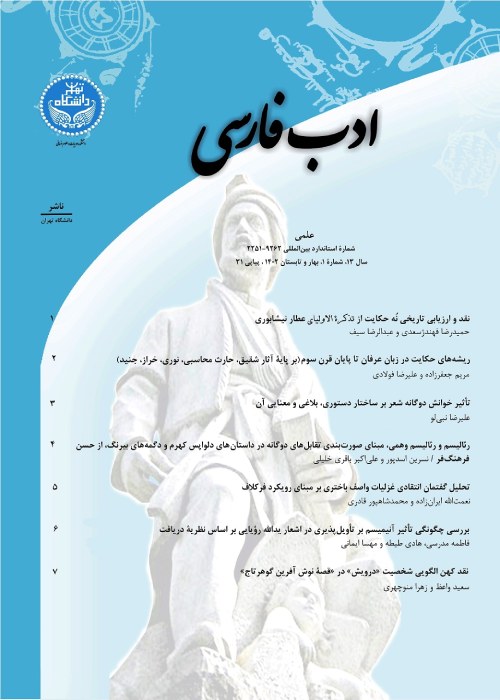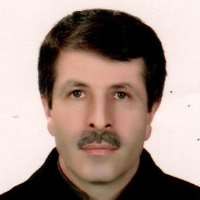An Analysis of the Similarities and Commonalities of Boof-e Koor̍s (The Blind Owl) Structure with the Student of Prague
Author(s):
Article Type:
Research/Original Article (دارای رتبه معتبر)
Abstract:
The Blind Owl is an artistic text with a psychological background. The novel has been written using the technique of Transposition. This technique has a long history in Europe, especially in the works of Hoffmann and Maupassant. Sadegh Hedayat, the author of the novel, has been influenced by the literary and artistic works, as well as the theories of the western psychoanalysts, such as Ewers, Freud, Jung, etc. One of the goals of psychoanalysis is to reveal important psychological aspects buried in the unconscious. One of the theories proposed in psychoanalysis is that “double” is one of the buried belongings of the human psyche, and some people can see the double of their psyche. In Freud’s psychology, human natural passions become important as the unconscious becomes important. As a result, the artists and writers influenced by Freud choose the psyche’s freedom and its tendency to deviate from the norm as the subject of their work. The world of The Blind Owl’s characters is overfilled with romantic perspectives and emotional feelings. In this novel, the influence of psychological perspective of “shading” and the tradition of focusing on the “double” in the world of narrative literature is observed more than any other perspectives. All the characters in the novel are in fact shadings or doubles of the protagonist. The representation of the characters in different personas has caused the development of the novel, the structuring of its world, and the complexity of its language. One of the works with which The Blind Owl has the most commonalities and similarities is the screenplay of The Student of Prague written by Hannes Heinz Ewers, whom Otto Rank has called the modern Hoffmann. Ewers wrote the screenplay of The Student of Prague in the genre of horror, adapting the works of his predecessors, including Goethe's play Faust, some of Hoffmann’s stories, etc. The screenplay was premiered in Germany in 1913, reformed in 1926, and voiced in 1935. The purpose of this article is to find the commonalities and similarities between these two works. To this end, a methodology of comparison has been applied: comparing the structures, the procedural development, the use of instruments and symbols, the role of the characters, the relationship of the characters with the protagonist, and the messages of the works. The results of the study indicate that the commonalities and similarities between The Blind Owl and The Student of Prague are more highlighted than the other works compared with The Blind Owl so far. These commonalities and similarities are conveniently seen in the elements mentioned in the methodology. Among the similarities in the area of content, the following can be mentioned: man’s destiny is subject to his emotions and his emotions are subject to chance; the ultimate value of life is unique to the supreme lover to whom everything must be sacrificed; a double could be more original than the real one.
Keywords:
Language:
Persian
Published:
Persian Literature, Volume:12 Issue: 2, 2023
Pages:
63 to 80
https://magiran.com/p2593359
دانلود و مطالعه متن این مقاله با یکی از روشهای زیر امکان پذیر است:
اشتراک شخصی
با عضویت و پرداخت آنلاین حق اشتراک یکساله به مبلغ 1,390,000ريال میتوانید 70 عنوان مطلب دانلود کنید!
اشتراک سازمانی
به کتابخانه دانشگاه یا محل کار خود پیشنهاد کنید تا اشتراک سازمانی این پایگاه را برای دسترسی نامحدود همه کاربران به متن مطالب تهیه نمایند!
توجه!
- حق عضویت دریافتی صرف حمایت از نشریات عضو و نگهداری، تکمیل و توسعه مگیران میشود.
- پرداخت حق اشتراک و دانلود مقالات اجازه بازنشر آن در سایر رسانههای چاپی و دیجیتال را به کاربر نمیدهد.
In order to view content subscription is required
Personal subscription
Subscribe magiran.com for 70 € euros via PayPal and download 70 articles during a year.
Organization subscription
Please contact us to subscribe your university or library for unlimited access!



